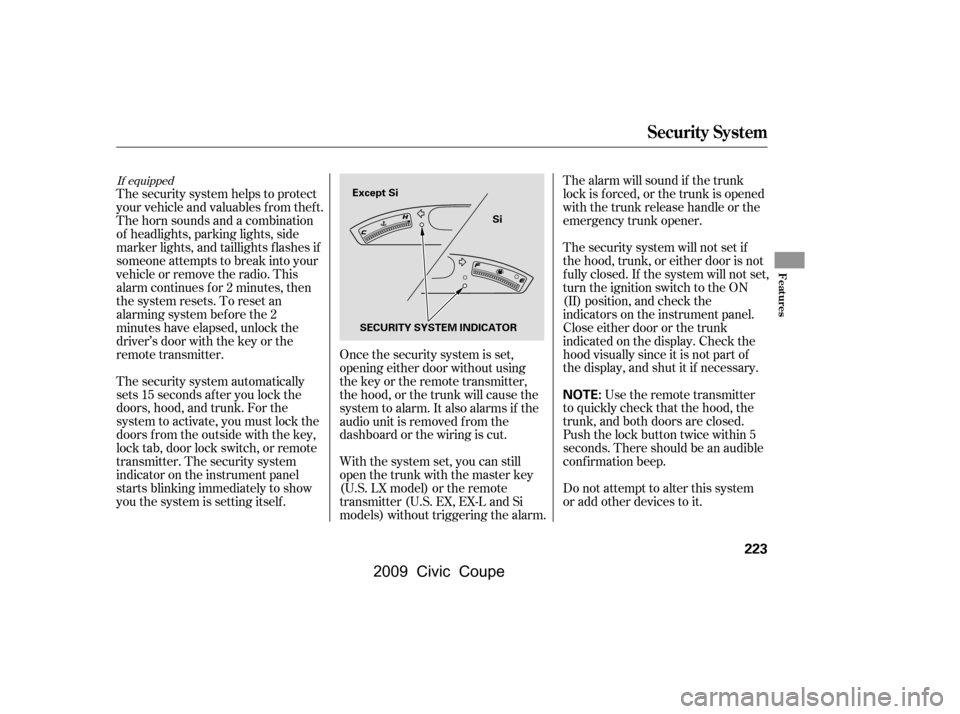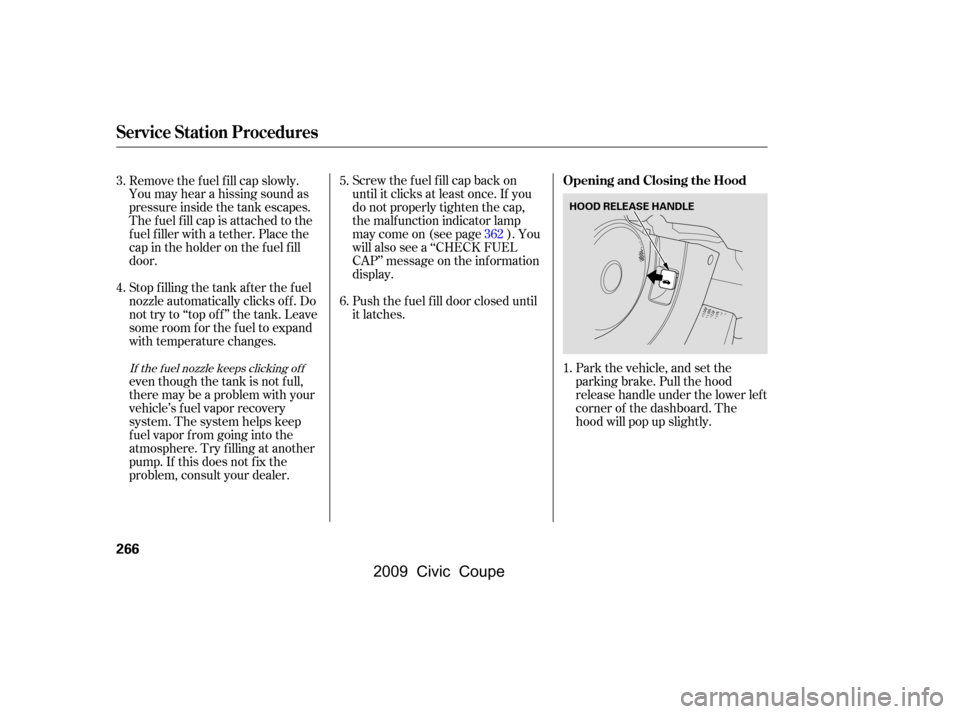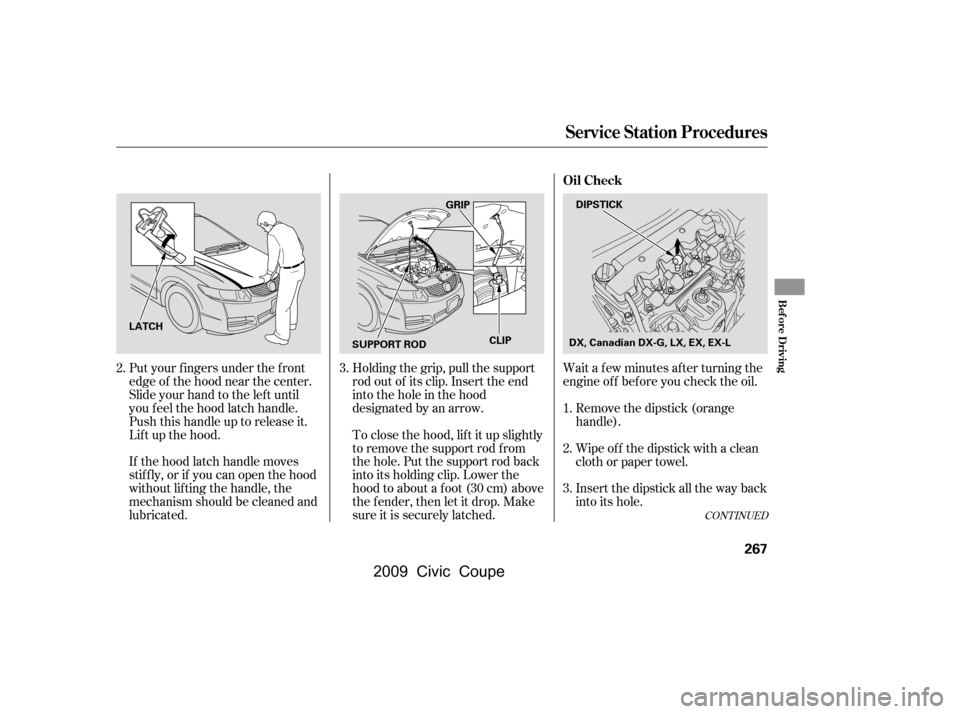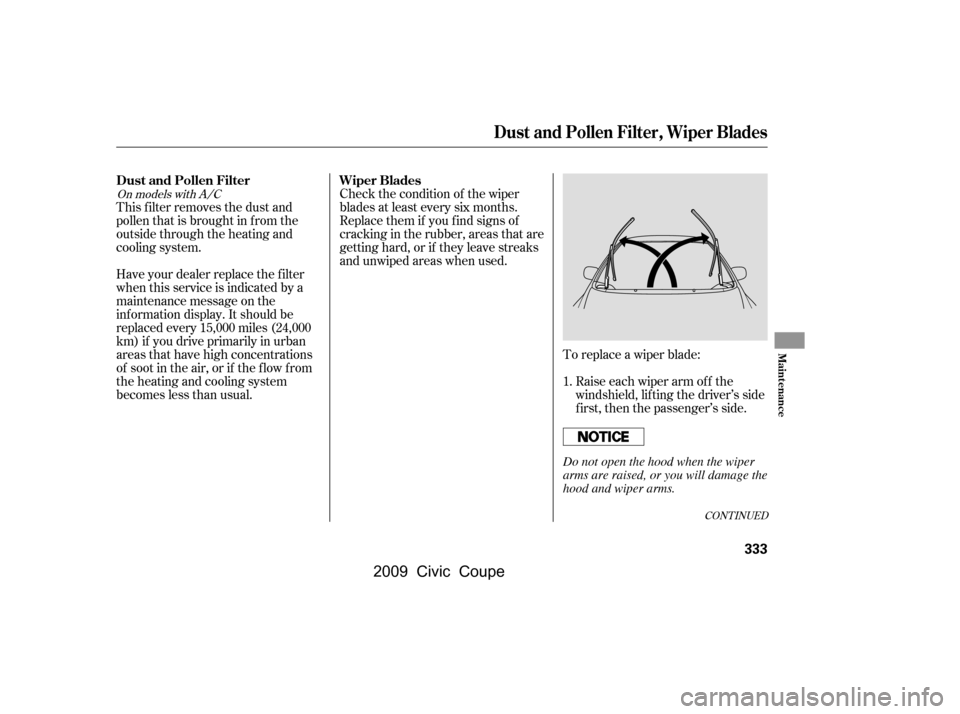Page 226 of 412

Once the security system is set,
opening either door without using
the key or the remote transmitter,
the hood, or the trunk will cause the
system to alarm. It also alarms if the
audio unit is removed f rom the
dashboard or the wiring is cut.
The security system helps to protect
your vehicle and valuables f rom thef t.
The horn sounds and a combination
of headlights, parking lights, side
marker lights, and taillights f lashes if
someone attempts to break into your
vehicleorremovetheradio.This
alarm continues f or 2 minutes, then
the system resets. To reset an
alarming system before the 2
minutes have elapsed, unlock the
driver’s door with the key or the
remote transmitter.
The security system automatically
sets 15 seconds after you lock the
doors, hood, and trunk. For the
system to activate, you must lock the
doors f rom the outside with the key,
lock tab, door lock switch, or remote
transmitter. The security system
indicator on the instrument panel
starts blinking immediately to show
you the system is setting itself . The security system will not set if
the hood, trunk, or either door is not
f ully closed. If the system will not set,
turn the ignition switch to the ON
(II) position, and check the
indicators on the instrument panel.
Close either door or the trunk
indicated on the display. Check the
hood visually since it is not part of
the display, and shut it if necessary.
With the system set, you can still
open the trunk with the master key
(U.S. LX model) or the remote
transmitter (U.S. EX, EX-L and Si
models) without triggering the alarm. The alarm will sound if the trunk
lock is f orced, or the trunk is opened
with the trunk release handle or the
emergency trunk opener.
Use the remote transmitter
to quickly check that the hood, the
trunk, and both doors are closed.
Push the lock button twice within 5
seconds. There should be an audible
conf irmation beep.
Do not attempt to alter this system
or add other devices to it.
If equipped
Security System
Features
223
NOTE:
SECURITY SYSTEM INDICATOR
Except Si
Si
�\f���—�\f���—�\f���y�
�
��
��������y���
�(�+�������\f�y�\f�������y
2009 Civic Coupe
Page 266 of 412
Bef ore you begin driving your
vehicle, you should know what
gasoline to use and how to check the
levels of important f luids. You also
need to know how to properly store
luggage or packages. The
inf ormation in this section will help
you. If you plan to add any
accessories to your vehicle, please
read the information in this section
first..............................
Break-in Period .264
.................
Fuel Recommendation .264
.........
Service Station Procedures .265
....................................
Ref ueling .265
Opening and Closing
................................
the Hood .266
...................................
Oil Check .267
.............
Engine Coolant Check .269
...............................
Fuel Economy .270
...
Accessories and Modif ications .273
.............................
Carrying Cargo .275
Bef ore Driving
Bef ore Driving
263
�\f���—�\f���—�\f���y�
�
����\f��\f���y���
�(�+�������\f�y�\f�������y
2009 Civic Coupe
Page 269 of 412

Park the vehicle, and set the
parking brake. Pull the hood
release handle under the lower lef t
corner of the dashboard. The
hood will pop up slightly.
Screw the f uel f ill cap back on
until it clicks at least once. If you
do not properly tighten the cap,
the malf unction indicator lamp
maycomeon(seepage).You
will also see a ‘‘CHECK FUEL
CAP’’ message on the inf ormation
display.
Push the f uel f ill door closed until
it latches.
Remove the f uel f ill cap slowly.
You may hear a hissing sound as
pressure inside the tank escapes.
The fuel fill cap is attached to the
f uel f iller with a tether. Place the
cap in the holder on the f uel f ill
door.
Stop f illing the tank af ter the f uel
nozzle automatically clicks of f . Do
not try to ‘‘top off’’ the tank. Leave
some room f or the f uel to expand
with temperature changes.
even though the tank is not f ull,
there may be a problem with your
vehicle’s fuel vapor recovery
system. The system helps keep
f uel vapor f rom going into the
atmosphere. Try f illing at another
pump. If this does not f ix the
problem, consult your dealer.
1.
5.
6.
4.
3.
362If the f uel nozzle keeps clicking of f
Service Station Procedures
Opening and Closing the Hood
266
HOOD RELEASE HANDLE
�\f���—�\f���—�\f���y�
�
����\f������y���
�(�+�������\f�y�\f�����
�y
2009 Civic Coupe
Page 270 of 412

Wait a f ew minutes af ter turning the
engine of f bef ore you check the oil.
Put your f ingers under the f ront
edge of the hood near the center.
Slide your hand to the lef t until
you f eel the hood latch handle.
Push this handle up to release it.
Lif t up the hood.
If the hood latch handle moves
stif f ly, or if you can open the hood
without lifting the handle, the
mechanism should be cleaned and
lubricated. To close the hood, lif t it up slightly
to remove the support rod f rom
the hole. Put the support rod back
into its holding clip. Lower the
hood to about a f oot (30 cm) above
the fender, then let it drop. Make
sure it is securely latched.Remove the dipstick (orange
handle).
Wipe of f the dipstick with a clean
cloth or paper towel.
Insert the dipstick all the way back
into its hole.
Holding the grip, pull the support
rod out of its clip. Insert the end
into the hole in the hood
designated by an arrow.
3.
1.
2.
3.
2.
CONT INUED
Service Station Procedures
Oil Check
Bef ore Driving
267
DIPSTICK
LATCH SUPPORT RODDX, Canadian DX-G, LX, EX, EX-L
CLIP
GRIP
�\f���—�\f���—�\f���y�
�
����\f������y���
�(�+�������\f�y�\f�������y
2009 Civic Coupe
Page 317 of 412
Open the hood, and remove the
engine oil f ill cap. Remove the oil
drain bolt and washer f rom the
bottom of the engine. Drain the oil
into an appropriate container.
Always change the oil and f ilter
according to the maintenance
messages shown on the inf ormation
display. The oil and f ilter collect
contaminants that can damage your
engine if they are not removed
regularly.
Run the engine until it reaches
normal operating temperature,
then shut it off.
Changing the oil and f ilter requires
special tools and access f rom
underneath the vehicle. The vehicle
should be raised on a service station-
type hydraulic lif t f or this service.
Unless you have the knowledge and
proper equipment, you should have
this maintenance done by a skilled
technician.
1. 2.
Changing the Engine Oil and Filter
314
DRAIN BOLT
WASHER
Si
DX, Canadian DX-G, LX, EX, EX-L WASHER DRAIN BOLT
�\f���—�\f���—�\f���y�
�
�����������y���
�(�+�������\f�y�\f���
���y
2009 Civic Coupe
Page 327 of 412
Your vehicle has halogen headlight
bulbs. When replacing a bulb, handle
it by its base, and protect the glass
f rom contact with your skin or hard
objects. If you touch the glass, clean
it with denatured alcohol and a clean
cloth.Open the hood.
To change a bulb on the driver’s
side, remove the coolant tube f rom
the two clips, then remove the
reserve tank f rom its holder by
pulling it straight up.
Theheadlightswereproperlyaimed
when your vehicle was new. If you
regularly carry heavy items in the
trunk, readjustment may be required.
Adjustmentsshouldbedonebyyour
dealer or another qualif ied
technician.
1.
Lights
Headlight A iming Replacing a Headlight BulbHigh Beam Headlight
324
COOLANT
TUBE
CLIP
Halogen headlight bulbs get very hot
when lit. Oil, perspiration, or a scratch
on the glass can cause the bulb to
overheat and shatter.
�\f���—�\f���—�\f���y�
�
�������
���y���
�(�+�������\f�y�\f�������y
2009 Civic Coupe
Page 336 of 412

Check the condition of the wiper
blades at least every six months.
Replace them if you f ind signs of
cracking in the rubber, areas that are
getting hard, or if they leave streaks
and unwiped areas when used.
This f ilter removes the dust and
pollenthatisbroughtinfromthe
outside through the heating and
cooling system.
Have your dealer replace the filter
when this service is indicated by a
maintenance message on the
inf ormation display. It should be
replaced every 15,000 miles (24,000
km) if you drive primarily in urban
areas that have high concentrations
of soot in the air, or if the f low f rom
the heating and cooling system
becomeslessthanusual.
To replace a wiper blade:
Raise each wiper arm of f the
windshield, lif ting the driver’s side
first, then the passenger’s side.
1.
CONT INUED
On models with A/C
Wiper Blades
Dust and Pollen Filter
Dust and Pollen Filter, Wiper Blades
Maint enance
333
Do not open the hood when the wiper
arms are raised, or you will damage the
hood and wiper arms.
�\f���—�\f���—�\f���y�
�
�����������y���
�(�+�������\f�y�\f�������y
2009 Civic Coupe
Page 360 of 412

Although this seems like a simple
procedure, you should take several
precautions.
Open the hood, and check the
physical condition of the battery.
In very cold weather, check the
condition of the electrolyte. If it
seems slushy or f rozen, do not try
jump starting until it thaws.
You cannot start your vehicle with an
automatic transmission by pushing
or pulling it.
To jump start your vehicle:
Turn of f all the electrical
accessories: heater, A/C, audio
system, lights, etc. Put the
transmission in neutral (manual)
or Park (automatic), and set the
parking brake.
The numbers in the illustrations
show you the order to connect the
jumper cables.
1.
2.
CONT INUED
Jump Starting
T aking Care of t he Unexpect ed
357
BOOSTER BATTERY
DX, Canadian DX-G, LX, EX, EX-L
A battery can explode if you do
not follow the correct procedure,
seriously injuring anyone
nearby.
Keep all sparks, open flames,
and smoking materials away
from the battery.
If a battery sits in extreme cold, the
electrolyte inside can f reeze.
Attempting to jump start with a f rozen
battery can cause it to rupture.
�����—�����—�����y�
�
�����������y���
�(�+���������y���������y
2009 Civic Coupe